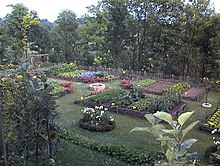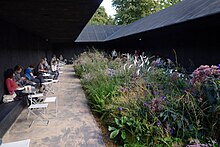Hortus conclusus

Hortus conclusus is a Latin term, meaning literally "enclosed garden". Both words in hortus conclusus refer linguistically to enclosure.[1] It describes a type of garden that was enclosed as a practical concern, a major theme in the history of gardening, where walled gardens were and are common.[2] The garden room is a similar feature, usually less fully enclosed.
Having roots in the
The Virgin Mary as hortus conclusus
The term hortus conclusus is derived from the

The verse "Thou art all fair, my love; there is no spot in thee" (4.7) from the Song was also regarded as a scriptural confirmation of the developing and still controversial doctrine of Mary's
The enclosed garden is recognizable in Fra Angelico's Annunciation (illustration at above left), dating from 1430-32.
Two pilgrimage sites are dedicated to Mary of the Enclosed Garden in the Dutch-Flemish cultural area. One is the statue at the hermitage-chapel in Warfhuizen: "Our Lady of the Enclosed Garden". The second, Onze Lieve Vrouw van Tuine (literally "Our Lady of the Garden"), is venerated at the cathedral of Ypres.
Actual gardens
All gardens are by definition enclosed or bounded spaces, but the enclosure may be somewhat open and consist only of columns, low hedges or fences. An actual walled garden, literally surrounded by a wall, is a subset of gardens. The meaning of hortus conclusus suggests a more private style of garden.

In the
The origin of the

The practical enclosed garden was laid out in the treatise by
Sitting, walking and playing music were the activities most often portrayed in the numerous fifteenth-century paintings and illuminated manuscripts, where strenuous activities were inappropriate. In Rome, a late fifteenth-century cloister at San Giovanni dei Genovesi was constructed for the use of the Genoese natio, an Ospitium Genoensium, as a plaque still proclaims, which provided shelter in cubicles off its vaulted encircling arcades, and a meeting place and shelter reuniting those from the distant home city.[11]

Somewhat earlier, Pietro Barbo, who became Pope Paul II in 1464, began the construction of a hortus conclusus, the Palazzetto del Giardino di San Marco, attached to the Venetian Cardinals' Roman seat, the Palazzo Venezia.[12] It served as Paul's private garden during his papacy; inscriptions stress its secular functions as sublimes moenibus hortos...ut relevare animum, durasque repellere curas, a garden of sublime delights, a retreat from cares, and praise it in classicising terms as the home of the dryads, suggesting that there was a central grove of trees, and mentioning its snowy-white stuccoed porticoes. An eighteenth-century engraving shows a tree-covered central mount, which has been recreated in the modern replanting, with box-bordered cross and saltire gravelled paths.[13]
The
Again in the age of the automobile, the enclosed garden that had never disappeared in Islamic society became an emblem of serenity and privacy in the Western world.
In art
The hortus conclusus was one of a number of depictions of the Virgin in the late Middle Ages developed to be more informal and intimate than the traditional hieratic enthroned Virgin adopted from Byzantine icons, or the
One type of depiction, not usually compatible with correct perspective, concentrates on showing the whole wall and several garden structures or features that symbolize the mystery of Christ's conception, mostly derived from the Song of Songs or other Biblical passages as interpreted by theological writers. These may include one or more temple or church-like buildings, an
A rather rare, late 15th century, variant of this depiction was to combine the Annunciation in the hortus conclusus with the , where it is hard to say if an allusion is intended.
An exhibition of later medieval visual representations of hortus inclusus was mounted at
-
Style of Dieric Bouts
-
Italian miniature, c. 1435
-
Early woodcut, c. 1460, hand-coloured
-
Bartolomé Bermejo, Virgen de Montserrat altarpiece, 1485
-
Cologne, ca. 1520
-
Juan de Juanes, after 1530
-
Woodcut dated 1418, but probably 1450s
Modern cultural references

The concept for the 2011 Serpentine Gallery Pavilion was the hortus conclusus, a contemplative room, a garden within a garden. Designed by Swiss architect Peter Zumthor and with a garden created by Piet Oudolf, the Pavilion was a place abstracted from the world of noise and traffic and the smells of London – an interior space within which to sit, to walk, to observe the flowers.[26]
See also
- CatholicConvent of the Hortus Conclusus
- Gaston Bachelard
- Locus amoenus
- Topophilia
- Renaissance garden
References
- ^ Clifford, A History of Garden design, (New York:Praeger) 1963:17.
- ^ Rob Aben and Saskia de Wit, The Enclosed Garden: History and Development of the Hortus Conclusus and its Re-Introduction into the Present-Day Urban Landscape (Rotterdam) 1999. A typological catalogue of design features and a design manual.
- ^ Stanley Stewart, The Enclosed Garden: The Tradition and Image in Seventeenth-Century Poetry (Madison: University of Wisconsin Press) 1966, discussed late sixteenth and seventeenth-century poetry in English; its four first chapters trace the hortus conclusus theme in European literatures and the visual arts.
- ^ Michelle P. Brown, "The World of the Luttrell Psalter" British Library 2006,
- ^ Brian E. Daley, "The 'Closed Garden'and the 'Sealed Fountain': Song of Songs 4:12 in the Late Medieval Iconography of Mary", Elizabeth B. Macdougall, editor, Medieval Gardens, Dumbarton Oaks Colloquium 9) 1986, traced the sudden development about 1400 of painted images of the Virgin Mary in a hortus conclusus.
- ^ The whole text Archived 2011-05-29 at the Wayback Machine
- ^ Timothy Husband, reporting the exhibition and its catalogue in The Burlington Magazine, 125, No. 967 (October 1983:643).
- ^ Clifford 1963, eo. loc..
- Subiaco, occupying Nero's former villa.
- ^ Masson, Italian Gardens (New York: Abrams) 1961:46.
- ^ Wolfgang Lotz, "Bramante and the Quattrocento Cloister" Gesta 12.1/2 (1973):111-121) p. 113.
- ^ It was dismantled and re-erected in 1910 to make space for Piazza Venezia.
- ^ Hinc hortos dryadumque domos et amena vireta/ Porticibus circum et niveis lustrata columnisLotz 1973 eo. loc. and figs 10 and 11.
- ^ "The Roman Forum". www.theromanforum.com. Retrieved 2020-08-18.
- ^ Schiller, 54; similar image on panel
- ^ Schiller, pp 52-55
- ^ Russian example, Tretyakov Gallery Moscow.
- ^ "Thy neck is like the tower of David built for an armoury, whereon there hang a thousand bucklers, all shields of mighty men."
- ^ "Who is she that looketh forth as the morning, fair as the moon, clear as the sun, and terrible as an army with banners?"
- ^ Schiller, pp 53-54
- ISBN 0-85331-270-2, another image
- ^ Exhibition catalogue, Marilyn Stokstad and Jerry Stannard, Gardens of the Middle Ages, Dumbarton Oaks and Spencer Museum of Art, University of Kansas (University of Kansas) 1983.
- ^ Husband 1983:644.
- ^ An estrade tree was pruned into a series of diminishing horizontal tiers like a sweetmeat stand, the French estrade coming from Spanish estrado, denoting the carpeted and raised section of a room (cf OED, s.v. "estrade", "estrado").
- ^ Husband, eo. loc..
- ^ "Serpentine Gallery Pavilion 2011 by Peter Zumthor". Serpentine Galleries. Retrieved 2020-08-18.
Further reading
- D'Ancona, Mirella Levi (1977). Garden of the Renaissance: Botanical Symbolism in Italian Painting. Firenze: Casa Editrice Leo S.Olschki. ISBN 9788822217899.
External links
 Media related to Hortus conclusus at Wikimedia Commons
Media related to Hortus conclusus at Wikimedia Commons- Hortus conclusus as one of a number of Devotional Images
- The Garden of Eden, a hortus conclusus by the Master of the Upper Rhineland
- Early Delights, excellent piece by Jemima Montagu on the symbolism of the garden










